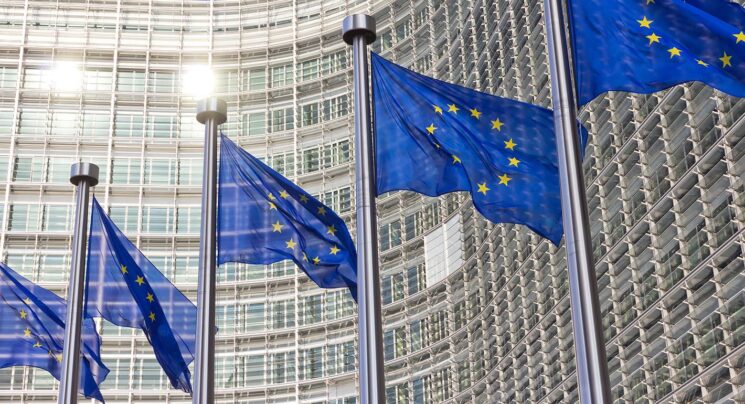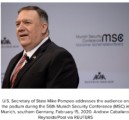While strategic autonomy seems firmly set to guide EU foreign policy, it carries significant risks—especially for democratic values. If it takes autonomy too far, the EU may find itself less able to advance, and achieve, its foreign policy goals.
The EU has placed strategic autonomy at the heart of its foreign policy. This has engendered much debate about what the concept means and how it is likely to affect the EU’s external action. Strategic autonomy goes hand in hand with other increasingly prominent notions like geopolitical power and European sovereignty that seem set to push the union is a similar direction. While a strong consensus appears to have taken shape in support of these concepts, more critical thinking is needed to understand the trade-offs they entail.
Those uneasy at the idea of strategic autonomy mostly weigh in with a familiar concern over its potential impact on NATO and U.S. security engagement with and in Europe. The EU’s foreign policy chief has lamented that this is a misdirected criticism. And indeed, the concept’s main problems are deeper: they revolve around the particular understandings of power on which the EU’s putative autonomy is based.
European policymakers’ statements define strategic autonomy as the capacity to act. In doing so, they mix two separate strands of policy. In the defense and political spheres, they use the concept to refer to a buildup of capabilities. In the economic and other spheres, they use it to denote a quest for lower levels of reliance on others. Both are intuitively reasonable, but neither gets to the core of why EU external action has struggled in recent years—in particular in relation to supporting liberal and democratic norms.
Capabilities Versus Choices
If one axis of autonomy amounts to a search for more EU defense and technological capabilities, it is not a new or controversial aim. But neither does this amount to a comprehensive vision for strategic leverage. Effective influence concerns the ways in which capacities to act are deployed—through what means, within what kinds of global relations, and to what ends.
In most instances, it is not an absence of capabilities that has held the EU back from acting autonomously in recent years. Rather, it is political choice—strategic judgments, whether good or bad, more than insuperable capacity constraints. Simply adding a modest layer of capabilities through more joint European projects will not, in itself, change that underlying reality.
It is unlikely that such additions would have led the EU to prevent Russia from annexing part of Ukraine in 2014 or engage successfully to defeat the regime of Syrian President Bashar al-Assad. It was not for want of a capacity to act that in the last decade the EU declined to fully support the Arab Spring uprisings, equivocated on Palestinian self-determination, twisted border control into its leading security doctrine, stepped back from further EU enlargement, narrowed the scope of its climate-security policies, and hitched its fortunes to discredited elites across the developing world.
In this sense, the plea for strategic autonomy rests on a faulty core diagnosis. Most frequently, the geostrategic concern arises not from the EU lacking the capacity to act but from the way that the union chooses to use the capacities it does possess.
Listing a standard menu of policy areas and saying the EU needs more capacity in each of them does not provide a geopolitical vision that corrects this shortcoming. Such an approach understands power in a narrow, mechanical fashion, in terms of hardware-type quantitative indicators. This overlooks the kinds of interwoven global relationships and substantive identities that are needed to give these capabilities effective leverage.
In this focus, it often appears as if the EU seeks to give itself state-like capacities to affirm its own evolving status, rather than assessing what kinds of influence really work. This echoes a long-noted distortion that EU policies are more about the union’s institutional status than about the de facto means to attain external results.
Autonomy Is Not a One-Way Street
While one axis of strategic autonomy is about bolstering the means of power, the other is about lessening external dependence. In defending this goal, the EU’s foreign policy chief has listed areas where the union is developing its own production and resources so as not to need those of others, linking this approach to his view that global interdependence is now a source of conflict, not harmony.
This element of autonomy entails a particular kind of power. It is power understood as insulation from exogenous impacts—that is, decreasing Europe’s vulnerability to the power and decisions of others. The catch here is that the EU’s autonomy from others will, almost by definition, give others more autonomy from the EU. The flip side of the EU’s multiple moves toward autonomy is that other powers will have less need to cooperate with the union in their own political-strategic actions.
In this way, the EU’s quest for strategic autonomy could risk undercutting, not driving, the projection of geopolitical power as well as its support for liberal-democratic values. The push for economic autonomy may add to security in the sense of insulating European states from other powers; but this is a stark contrast to the idea of the EU influencing others and shaping international actions in a more enduring fashion.
Herein lies the risk of an autonomy trap. The EU has felt increasingly vulnerable, so it strikes out for autonomy; this dilutes the union’s leverage over others; as a result, the EU feels even weaker, so it seeks even more autonomy; this further weakens its leverage over others; and so on. The more the EU turns to building its self-sufficiency, the more it chokes off the external pathways that allow its capabilities to effect change from others.
The EU’s line is that autonomy does not entail outright isolation or protectionism. Undoubtedly, this is true. But simply stating this rather low-threshold fact does not solve the tensions and trade-offs that the concept almost certainly involves. The EU remains an open trader and insists it seeks deeper international partnerships, firmer and wider multilateral commitments, and more security engagement; but then it also declares an aim to achieve autonomy from such external factors. The strategy is tantamount to seeking external ties that give the EU more influence over others while diluting those ties that give others influence over the EU.
Logically, this must be a circle that is almost impossible to square. At the very least, it must be extremely difficult to paint the external other as something from which the EU needs autonomy and separation and then appeal to that same other for deeper cooperation in the name of shared objectives. Like many EU concepts of recent years, strategic autonomy has a certain flavor of having one’s cake and eating it too.
The EU’s riposte seems to be that it can have the best of both worlds, combining a degree of independence with degrees of interdependence. Such an insistence is embodied in the union’s emergent use of the rather challenging term “open strategic autonomy.” This may indeed be possible in some areas of the EU’s trade or digital technology policies. Still, it feels like the union is setting out to play a single game of sport with two different sets of rules, flitting between the two as the game ebbs and flows.
European leaders routinely frame the EU’s choice as autonomy versus dependence. But much of global affairs runs on a dynamic of mutual interdependence that fits neither of these extremes. Think of climate policy, for instance, where the concept of autonomous EU sovereignty is questionable when capacities to act need to be interconnected at the global level to have any impact.
Curiously, this is exactly the argument that EU politicians and analysts rightly make against myopic Brexiteers: autonomy and formal sovereignty do not buy the external leverage to get things done. Yet, the EU then appears to adopt this same logic as its own guiding foreign policy principle. Of course, the union’s line is that sovereignty and independence at the European level are superior. But simply scaling up old concepts from the national level is unlikely to rectify the reasons why those concepts have failed for many decades.
Prioritizing protective autonomy gives the impression that the EU’s main challenge is to preserve the status quo rather than drive global change. Indeed, the EU concepts promoted in recent years—sovereignty, geopolitical power, resilience—have strikingly conservative overtones. Resilience can be defined as a country’s or system’s ability to return to its initial state; why that above all other possible concepts should be deemed in the EU’s interest is not clear. Autonomy is about guarding against externally driven change, not about making the international system more adaptable, more democratic, or forward looking.
Acknowledging the Trade-offs
Autonomy might be what governments and populations legitimately decide they prefer. But EU leaders need to acknowledge the trade-offs it involves. Pursued as the dominant organizing principle for EU external action, strategic autonomy will likely attenuate the union’s leverage over political instability, democratic transitions, climate policies, violence, and terrorism in other states. Such an approach will give other powers more scope to resist EU pressure and engagement.
Contrary to official arguments, the union’s stance is redolent of lower, not heightened, foreign policy ambition. There may be well-reasoned grounds for such a turn, but policymakers need to recognize the trade-offs and embed them in a coherent vision that does not promise every strategic tenet and its exact opposite simultaneously.
In a new book, I chart how this debate about autonomy sits atop a decade-long trend in EU external action toward what can be termed protective security: a shift away from the union’s erstwhile transformative power toward defensive self-protection. Developing an outside-in framework for EU foreign policy, this book explains how the origins of today’s strategic narratives can be traced to agendas that go well beyond the policy positions of the current EU leadership. The prominent discourse about autonomy and sovereignty is one expression of a wider recalibration in EU external action toward narrowed forms of security. This aim is perhaps more achievable and more necessary in some senses, but it also lessens what the EU can hope to achieve in the world.
The EU needs a far clearer assessment of whether this is really the optimal way to undergird European sovereignty—if this is understood as the union’s practical ability to achieve ambitious policy goals. A recurring and upbeat claim from European ministers and leaders is that the EU has lost its naivete in its search for self-regarding self-reliance. Yet, the union risks slipping back into an earlier naivete of expecting too much from some very old realpolitik concepts.
Many think tanks and analysts have acted as cheerleaders for the EU’s turn to the realpolitik concepts of geopolitical power, autonomy, sovereignty, and the like. This reflects a curiously conservative outlook at the analytical level. For years, much analysis has taken the EU to task for failing to live up to its pretensions to be a different, postmodern, and less traditional power. Yet, now that the EU seems to have set its course even more explicitly and firmly in that very direction, many seek to help it along its retrofitted way.
The EU has developed a habit of generating ostensibly guiding concepts without defining what these mean or offering indicators to measure their effectiveness. While the consensus behind the need for strategic autonomy is strong and undoubtedly set to influence policy developments, there needs to be more critical input on the concept’s internal inconsistencies and possible drawbacks.
This article is part of the European Democracy Hub initiative run by Carnegie Europe and the European Partnership for Democracy.






Leave a Reply